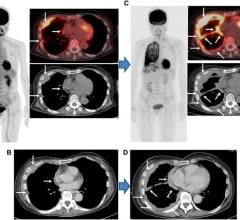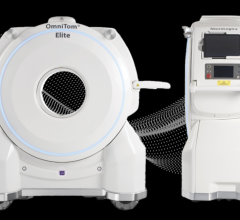News | December 03, 2013
Treatment Plans for Brain Metastases More Accurately Determined With Aid of Molecular Imaging Tracer
December 3, 2013 — Imaging with the molecular imaging tracer 18F-FDOPA can help distinguish radiation-induced lesions from new tumor growth in patients who have been treated with radiation for brain metastases, according to new research published in The Journal of Nuclear Medicine. Using this amino acid tracer, researchers found that physicians could accurately differentiate the two types of lesions 83 percent of the time. Progression-free survival could also be predicted through evaluating the 18F-FDOPA imaging results.
Brain metastases occur in 20-40 percent of all cancer patients, particularly in those with non-small cell lung cancer, breast cancer and melanoma. They account for 170,000 new cases per year in the United States, and prognosis is poor. Treatment for brain metastases typically includes a combination of surgery, radiation treatment and chemotherapy.
“Histopathological changes in neural tissue treated with radiation could trigger clinical and imaging manifestations which are very similar to those caused by tumor growth,” said Karlo Lizarraga, M.D., M.S. and lead author of the study “18F-FDOPA PET for Differentiating Recurrent or Progressive Brain Metastatic Tumors from Late or Delayed Radiation Injury After Radiation Treatment.” “The challenge is then to differentiate whether these manifestations are due to radiation or to tumor progression or recurrence. Accurate and timely distinction between these two possibilities can significantly affect patient care, and outcome for treatment modalities are completely different for each case.”
In the retrospective study, researchers analyzed images from 32 patients who had 83 previously irradiated brain metastases and who underwent 18F-FDOPA positron emission tomography (PET). The studies were analyzed both semiquantitatively and visually to determine whether lesions were caused by radiation injury or were recurrent or progressive brain metastases. Results were verified by histopathological analysis or clinical follow-up. The prognostic power of 18F-FDOPA in predicting progression-free survival and overall survival was also analyzed with the Kaplan-Meier and Cox regression methods.
The best overall accuracy for differentiating between the two types of lesions was achieved using visual scoring, which had a sensitivity of 81.3 percent, a specificity of 84.3 percent and an overall accuracy of 83.1 percent. The semiquantitative analysis resulted in a sensitivity of 81.3 percent, a specificity of 72.5 percent and an overall accuracy of 75.9 percent.
Researchers also found that evaluations with 18F-FDOPA PET was highly prognostic of progression-free survival, as lesions with a negative PET result had a mean time to progression that was 4.6 times longer than lesions with positive 18F-FDOPA PET results. Additionally, a trend toward predicting overall survival was also seen.
“18F-FDOPA PET imaging is currently available in few centers. The longer physical half-life of 18F-FDOPA, when compared to other amino acid tracers, gives it the advantage of potential automatedproduction and transport to PET centers for widespread use,” said Lizarraga.
The study, along with the names of the authors, is available on the Society of Nuclear Medicine and Molecular Imaging (SNMMI) website.
For more information: www.snmmi.org
© Copyright Wainscot Media. All Rights Reserved.
Subscribe Now


 July 30, 2024
July 30, 2024 








